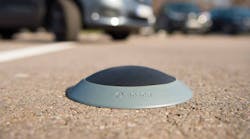There are times and places where finding a parking space at a mall, airport, or other facility is an exercise in futility and a waste of time. Now, Parkki, a French purveyor of smart-parking infrastructure has teamed with Actility, a provider of IoT connectivity solutions, to try to ease the parking crunch. Parkki currently deploys thousands of LoRaWAN sensors using Actility’s ThingPark Enterprise platform, allowing to determine the number of places left, to get directions to a free parking place, and more.
The number of parking spaces at a large supermarket can range between 700 and 3000 for the biggest ones. To date, Parkki has deployed 6000 smart-parking sensors in various installations. For example, for the Super U supermarket in Saint Jean de Monts, France, Parkki is currently installing four outdoor gateways and 400 Bosch smart-parking sensors connected to LoRaWAN. A new deployment is planned on Reunion Island with 700 sensors.
Parkki’s multi-technology, intelligent and connected parking platform is a turnkey solution that connects all parking spaces, supervises them in real time, and redistributes information to users. For parking-lot managers and motorists, it is the only tool compatible with all smart-parking devices: barriers, radar sensors on lighting, video analysis, and ground sensors. It is a real-time supervision solution for all parking spaces that allows:
- Real-time knowledge of free parking spaces
- Data streaming to control parking spaces
- Continuous improvement adapted to user behavior.
- Driver guidance (mobile application and staking)
Parkki’s solutions are particularly adapted to the retail sector. Already present in many retail chains, Parkki has for several years been addressing the strategic challenge of establishing a link between what’s happening in the parking lot and the commercial activity of the retail centers (Figure 1). Parkki’s value to retailers lies in interpreting the outdoor key performance indicators (KPIs; these include metrics like vehicle flows, availability of parking spaces, alerts, and car parking) and the commercial activities thanks to the indoor KPIs (people flows, people count, turnover, customer path, and frequency of visit).
Specific use cases require Wi-Fi, 4G, and/or ZigBee communication technologies, but LoRaWAN in particularly is an efficient way to communicate data for sensors installed on the ground. It is reliable and low in cost, and customers appreciate the open system and non-proprietary aspect of this technology.
Using smart-parking sensors with LoRaWAN and well-connected control systems allow drivers to easily find free parking spots, avoid congestion, and reduce fuel consumption and pollution. And this IoT solution can be implemented with a fast infrastructure setup without transforming the entire area into a construction site. LoRa-enabled parking sensors can be deployed throughout urban areas, enabling parking operators to capture and analyze occupancy data in real time. Connected road signs and online applications can display information about available parking spots. Actility provides the IoT connectivity platform for cities and for public and private parking operators in the form of the LoRaWAN network server and its ThingPark IoT platform for network management.
LoRaWAN is a widely-used wireless protocol that allows battery-operated devices to communicate with IoT applications via long-range, wireless connections, allowing longer battery life and thus lowering the cost of device ownership. LoRaWAN is especially useful in large-scale deployments because of its availability, cost, and reach; its use of unlicensed spectrum; and the availability of standardized, low-cost modules with long battery life.


